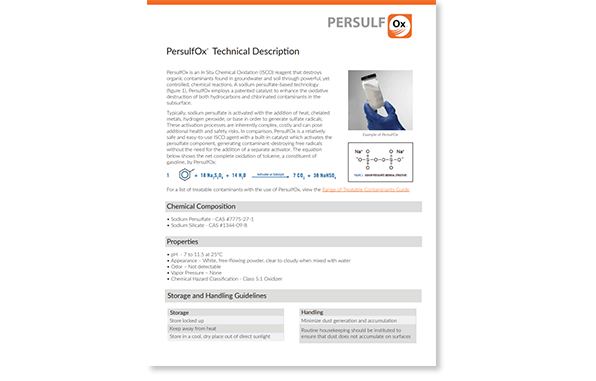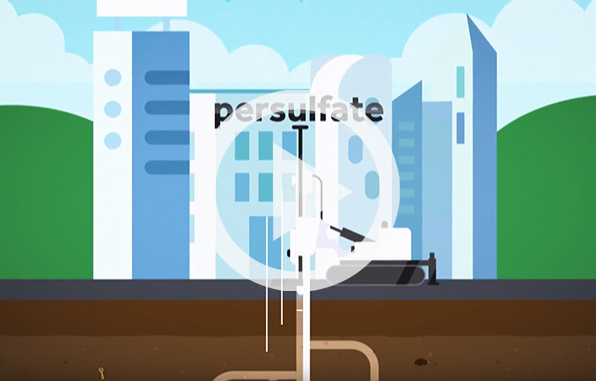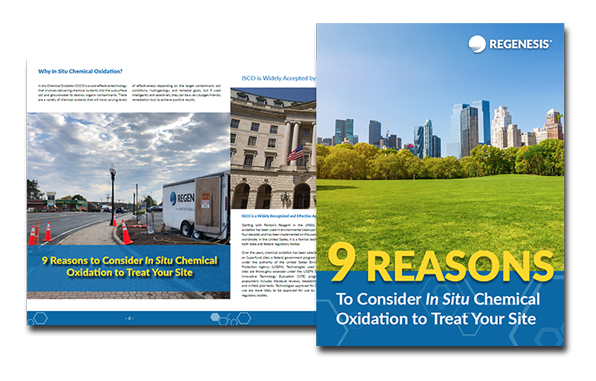


Advancing the Science of Activated Persulfate with Built-In Activation, Ease-of-Use and Flexible Formulations
PersulfOx®Catalyzed Persulfate
- Promotes rapid and sustained in situ oxidation of a wide-range of organic contaminants
- Contains a built-in catalyst that remains active through the entire lifespan of the persulfate oxidation reaction
- The catalyst also eliminates the need for the co-application of alternate and potentially hazardous activation chemistries
- Contaminant oxidation performance equivalent to best alternative persulfate activation methods
- Fewer health and safety concerns than with use of traditional activation methods such as heat, chelated metals, hydrogen peroxide or base
- Single component product results in simplified logistics and application
- No additional containers or multi-step mixing ratios required prior to application
- Compatible with combined remedy approaches including enhanced biodegradation
PersulfOx SP
- Promotes rapid and sustained in situ oxidation of a wide-range of organic contaminants
- Designed specifically for use when a separate chemical activation process such as iron activation is required
- Once the activating chemical is consumed, a level of radical formation is sustained as a result of the PersulfOx catalyst’s persistence
- Can be used as a follow-on treatment to REGENESIS’ PersulfOx Catalyzed Persulfate technology
- Compatible with combined remedy approaches including enhanced biodegradation
RESOURCES
PersulfOx Catalyzed Persulfate
Advancing Activated Persulfate Science with Built-In Activation and Ease-of-Use
PersulfOx is an advanced in situ chemical oxidation (ISCO) reagent that destroys organic contaminants found in groundwater and soil through abiotic chemical oxidation reactions. It is an all-in-one product with a built-in catalyst which activates the sodium persulfate component and generates contaminant-destroying free radicals without the costly and potentially hazardous addition of a separate activator. The patented catalyst enhances the oxidative destruction of both petroleum hydrocarbons and chlorinated contaminants in the subsurface.
Typically, sodium persulfate is activated with the addition of heat, chelated metals, hydrogen peroxide, or base in order to generate sulfate radicals. These activation processes are inherently complex, costly and can pose additional health and safety risks. In comparison, PersulfOx is a relatively safe and easy-to-use ISCO agent.
PersulfOx utilizes a unique silica-based, microscopic surface on which oxidants and contaminants can come together and react in a distinct and efficient process known as “surface mediated oxidation.” During this process, oxidation reactions occur repeatedly on the surface of the catalyst serving several contaminant-reducing functions:
- The generation of sulfate radical and other oxidizing species
- Accelerated oxidation through the adsorption of contaminant molecules and other oxidizing species
- Catalyzes direct and free-radical-mediated oxidation by sodium persulfate

Intellectual Property Statement – Non-Infringement of ANY other technologies
PersulfOx employs only advanced technologies developed by REGENESIS.
However REGENESIS has also secured a license to US Patent No 7,576,254 and Canadian Patent No. 2,555,484. Thus anyone purchasing PersulfOx can rest assured that they are free to perform alkaline activation of the product.
PersulfOx SP
For use on Projects Specifying the use of Sodium Persulfate and a Separate Chemical Activator such as Alkaline Activation, Hydrogen Peroxide Activation, or Iron Activation
PersulfOx SP is part of the PersulfOx line of in situ chemical oxidation reagents which, when used for environmental remediation, is capable of destroying organic contaminants in groundwater and soil through powerful chemical oxidation reactions. PersulfOx SP was formulated for use on projects specifying the use of persulfate and a separate chemical activation process such as iron activation. It can also be used as a follow-on treatment to REGENESIS’ PersulfOx Catalyzed Persulfate technology.
When mixed with water PersulfOx SP forms a solution that can be mixed with soil or injected into subsurface groundwater along with a chemical activation technology (i.e. chelated iron, etc.). Upon activation the product produces a suite of powerful oxidizing radicals which destroy a broad range of pollutants. Once the activating chemical is consumed, a level of radical formation is sustained as a result of the PersulfOx catalyst’s persistence.
Traditional methods of activation are known to be short-lived, requiring multiple reapplications of costly chemical activator. By replacing sodium persulfate with PersulfOx SP, the environmental professional gains all the benefits of traditional activation technologies PLUS the assurance that after the chemical activator is consumed, the catalyst remains behind. The remaining catalyst continues the formation of the desired pollutant destroying oxidation reactions.
In the event that a remediation program involving PersulfOx Catalyzed Persulfate requires multiple injections of oxidant the practitioner may determine that a full measure of catalyst is not required in which case follow-on applications of PersulfOx SP may be appropriate.
1 US and international patents apply. License to practice technology granted by REGENESIS.
Target Contaminants:
Petroleum Hydrocarbons
- Benzene, Toluene, Ethylbenzene and Xylenes (BTEX)
- Gasoline Range Organics (GRO) (C6-C10-12)
- Diesel Range Organics (DRO) (C8-12-C24-26)
- Oil Range Organics (ORO) (C22-32)
- Creosote (coal tar)
- Methyl-Tertiary Butyl Ether (MTBE)
- Tert-Butyl Alcohol (TBA)
- cis-1,2 Dichloroethene (DCE)
- Vinyl chloride (VC)
Chlorinated Compounds
- Chlorinated Solvents
- Tetrachloroethylene (PCE)
- Trichloroethene (TCE)
- cis-1,2 Dichloroethene (DCE)
- Vinyl chloride (VC)
- Tetrachloroethane
- Trichloroethane (TCA)
- Dichloroethane (DCA)
- Carbon tetrachloride
- Chloroethane
Ethers
- 1,4-Dioxane
For a complete listing of treatable contaminants please visit our Range of Treatable Contaminants Page
Soil Oxidant Demand (SOD) testing can be used to assess the suitability of an in situ chemical oxidation approach at your site and further estimate the amount of oxidant consumed by the soil matrix during ISCO applications. For more information download the Soil Oxidant Demand document.
Typical Soil and Groundwater Remediation Application Methods:
- Permanent injection wells
- Direct-push injection (barriers and grids)
- Soil borings
- Excavation applications into soil or on top of bedrock
- Soil mixing, handling and milling approaches
- Gravity feed
Next Steps:
If you currently have a project and need a remediation solution now, visit our Request a Design page.
Have questions or want to explore some ideas? Contact Us to get in touch with a local representative.

 Americas
Americas Europe
Europe Français
Français Deutsch
Deutsch Italiano
Italiano Español
Español





